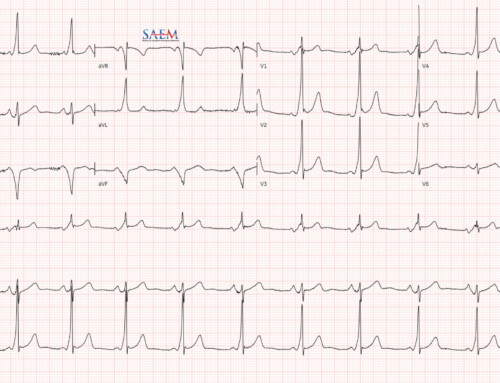 Case: A 58 year-old female presents with a one-day history of worsening right lower extremity pain and swelling, and an acute onset of dyspnea. Her past medical history consists of stage IV renal cell carcinoma diagnosed six months previously. Triage vitals are remarkable for a heart rate of 120 beats per minute and a blood pressure of 68/48 mmHg. What is the diagnosis?
Case: A 58 year-old female presents with a one-day history of worsening right lower extremity pain and swelling, and an acute onset of dyspnea. Her past medical history consists of stage IV renal cell carcinoma diagnosed six months previously. Triage vitals are remarkable for a heart rate of 120 beats per minute and a blood pressure of 68/48 mmHg. What is the diagnosis?
Poll Results
[plot id=”1″] [su_spoiler title=”Answer” style=”fancy” icon=”caret”]Phlegmasia Cerulea Dolens
Explanation
Phlegmasia cerulea dolens is a rare syndrome of acute massive venous thrombosis of the lower extremities. The classic clinical triad includes acute ischemic pain, limb swelling, and a blue or violaceous discoloration of the skin.1 Underlying malignancy is present in approximately one third of patients.1,2 Other risk factors include:
- Presence of a hypercoagulable syndrome
- Venous stasis
- Use of contraceptive agents
- Inferior vena cava filter insertion
This disease process carries a high-risk morbidity and mortality.
Important considerations:1–3
- Venous gangrene 40-60%
- Amputation 20-50%
- Concomitant pulmonary embolism 29%
- Mortality up to 40%
Management priorities include stabilization of the patient and aggressive management of the venous thrombus for life and limb preservation. Due to the relative infrequency of cases, there is no consensus regarding optimal treatment, and a wide variation of techniques have been used including systemic anticoagulation and thrombolysis, surgical thrombectomy, and more recently percutaneous mechanical thrombectomy and catheter guided thrombolysis.3,4 Urgent specialist consultation in the ED is advised to assist in managing this dangerous condition.
Case Conclusion
Point of care ultrasound demonstrated septal deviation and right ventricular dilation on apical four chamber view, and a deep venous thrombosis in the lower extremities. A chest CT confirmed bilateral pulmonary emboli. The patient was admitted to the intensive care unit for stabilization and the Thrombosis and Interventional Radiology teams were consulted for assistance in acute management.
[/su_spoiler]Master Clinician Bedside Pearls
Mark Reardon, MD FRCP
Assistant Professor of Emergency Medicine
University of Ottawa




